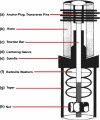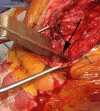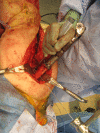Surgical technique: Methods for removing a Compress® compliant prestress implant
- PMID: 22002827
- PMCID: PMC3293961
- DOI: 10.1007/s11999-011-2128-z
Surgical technique: Methods for removing a Compress® compliant prestress implant
Abstract
Background: The Compress® device uses a unique design using compressive forces to achieve bone ingrowth on the prosthesis. Because of its design, removal of this device may require special techniques to preserve host bone. DESCRIPTION OF TECHNIQUES: Techniques needed include removal of a small amount of bone to relieve compressive forces, use of a pin extractor and/or Kirschner wires for removal of transfixation pins, and creation of a cortical window in the diaphysis to gain access to bone preventing removal of the anchor plug.
Methods: We retrospectively reviewed the records of 63 patients receiving a Compress® device from 1996 to 2011 and identified 11 patients who underwent subsequent prosthesis removal. The minimum followup was 1 month (average, 20 months; range, 1-80 months). The most common reason for removal was infection (eight patients) and the most common underlying diagnosis was osteosarcoma (five patients). Three patients underwent above-knee amputation, whereas the others (eight patients) had further limb salvage procedures at the time of prosthesis removal.
Results: Five patients had additional unplanned surgeries after explantation. Irrigation and débridement of the surgical wound was the most common unplanned procedure followed by latissimus free flap and hip prosthesis dislocation. At the time of followup, all patients were ambulating on either salvaged extremities or prostheses.
Conclusion: Although removal of the Compress® device presents unique challenges, we describe techniques to address those challenges.
Figures












References
-
- Bini SA, Johnston JO, Martin DL. Compliant prestress fixation in tumor prostheses: interface retrieval data. Orthopedics. 2000;23:707–711. - PubMed
-
- Chen CM, Disa JJ, Lee HY, Mehrara BJ, Hu QY, Nathan S, Boland P, Healey J, Cordeiro PG. Reconstruction of extremity long bone defects after sarcoma resection with vascularized fibula flaps: a 10-year review. Plast Reconstr Surg. 2007;119:915–924. doi: 10.1097/01.prs.0000252306.72483.9b. - DOI - PubMed
-
- Dion N, Sim FH. The use of allografts in orthopaedic surgery. Part I: The use of allografts in musculoskeletal oncology. J Bone Joint Surg Am. 2002;84:644–654.
MeSH terms
LinkOut - more resources
Full Text Sources
Medical
Research Materials

